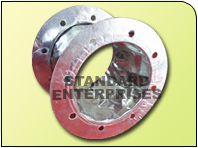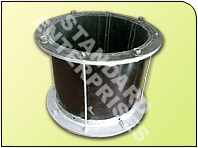High Temperature Glass Fabric Expansion Joints
High temperature glass fabric expansion joints are flexible connectors that are fabricated primarily from high temperature resistant fiberglass cloth. They are designed to accommodate movements and misalignments in piping and ducting systems, particularly where there are significant temperature fluctuations.
We developed high quality Non Metallic Fabric Expansion Joints from Heat Resisting Fabrics. These joints are suitable for duct inside temperature as high as 800 deg. C.
Now Engineers are preferring Fabric Expansion joints compared to Metallic Expansion joints because of following reasons
- Fabric Expansion Joints can take more misalignment & vibration
- Fabric Expansion Joints are easy to replace
- Fabric Expansion Joints are easy to repair
Key Features of High Temperature Glass Fabric Expansion Joints
High-temperature glass fabric expansion joints are designed to accommodate movement and isolate vibration between equipment such as ductwork, blowers, and fans. They play a critical role in industries where high temperatures are prevalent, such as power generation, steel mills, cement production, and various chemical processes. The following are key features of these expansion joints
- Temperature Resistance : They can operate in high-temperature environments, often up to 1000°F (538°C) or even higher depending on the specific type of glass fabric used.
- Flexibility : These expansion joints are designed to handle axial, lateral, and angular movements resulting from thermal growth, mechanical forces, or other operational factors.
- Chemical Resistance : Many glass fabric materials are treated to resist degradation from a variety of corrosive gases and chemicals commonly found in industrial environments.
- Flame Resistance : These joints are typically non-combustible, making them ideal for areas where flame or fire safety is a concern.
- Abrasion Resistance : Some glass fabric expansion joints come with an abrasion-resistant surface or finish to prolong their life in environments where wear and tear is prevalent.
- Low Thermal Conductivity : They act as insulators, minimizing the transfer of heat across the joint.
- Noise and Vibration Isolation : Helps in reducing vibration transmission and noise, providing smoother operation and reducing wear on equipment.
- Customizable : Can be custom-engineered and fabricated to fit a wide range of sizes, shapes, and configurations to meet specific application needs.
- Long Service Life : With proper maintenance and under the right conditions, these expansion joints can offer a long service life, providing value over time.
- Easy Installation and Maintenance : Many designs are made to be easily installed and replaced. They often come with flanges or belts for attachment, ensuring secure fitting.
- Weather Resistance : Many are designed to resist the detrimental effects of UV rays, ozone, and various weather conditions, making them suitable for both indoor and outdoor applications.
- Compact Design : For applications with limited space, these joints are often made to be as compact as possible while still delivering the desired performance.
- Lightweight : Despite their robust capabilities, these expansion joints are often lightweight, aiding in installation and handling.
It's essential to choose the right type of high-temperature glass fabric expansion joint based on specific application requirements and operating conditions. Collaborating with a reliable manufacturer or specialist can ensure that the selected product will deliver optimal performance and longevity.
Benefit of High Temperature Glass Fabric Expansion Joints
High Temperature Glass Fabric Expansion Joints are essential components in various industrial settings, especially in systems that transport hot gases or materials. These expansion joints play a crucial role in compensating for the movement caused by thermal expansion, mechanical vibrations, or operational changes. Here are some benefits of using High Temperature Glass Fabric Expansion Joints
- Thermal Stability : These expansion joints can withstand high temperatures without compromising their structural integrity. This means they are suitable for applications such as exhaust systems, flue gas ducts, and other high temperature environments.
- Flexibility : Glass fabric expansion joints can absorb multi-directional movements, allowing them to handle axial, lateral, and angular displacements.
- Corrosion Resistance : The materials used in high-temperature glass fabric expansion joints resist corrosion, ensuring a long service life even in challenging environments.
- Vibration Damping : Expansion joints can dampen and isolate vibrations, which is crucial for protecting equipment and piping from potential damage and reducing noise.
- Low Maintenance : Due to their robust design and material choice, these expansion joints often require minimal maintenance.
- Cost-Efficient : By preventing damage caused by thermal expansion and vibrations, these expansion joints can reduce downtime, maintenance costs, and potential replacement of adjacent equipment.
- Customization : High-temperature glass fabric expansion joints can be designed to fit specific requirements in terms of size, shape, and performance, making them suitable for various applications.
- Lightweight : Compared to metal expansion joints, glass fabric variants are lightweight, making installation easier and reducing the load on supporting structures.
- Good Chemical Resistance : These expansion joints often exhibit good resistance to a wide range of chemicals, further enhancing their longevity in various industrial applications.
- Safety : Preventing leaks and ruptures in systems carrying hot gases or liquids is crucial for safety. Reliable expansion joints ensure the system remains sealed and reduces the risk of accidents.
In conclusion, High Temperature Glass Fabric Expansion Joints offer a reliable solution for managing the thermal expansion and movements in various industrial systems. Their durability, flexibility, and resistance to harsh conditions make them an essential component in ensuring the smooth operation of these systems.
Applications of High Temperature Glass Fabric Expansion Joints
High Temperature Glass Fabric Expansion Joints are specially designed to accommodate thermal expansion and movement in industrial installations. They play a crucial role in maintaining the integrity and functionality of systems that experience temperature changes, vibration, or movement due to operational parameters. These expansion joints are often employed in environments that have high temperatures but where the medium does not attack glass. The fabric used in these joints is both flexible and durable, making it ideal for these applications.
Some of the primary applications of High Temperature Glass Fabric Expansion Joints include
- Power Generation Plants : In coal-fired power plants, gas turbine installations, and other power generation facilities, expansion joints can be used in the duct systems that carry hot gases and flue gases.
- Industrial Furnaces and Ovens : Expansion joints are used to accommodate the expansion and contraction of structural components due to temperature fluctuations, ensuring that the structures remain undamaged.
- Cement and Lime Production : The production of cement and lime involves high temperatures. Expansion joints are often found in the ducts and systems that handle exhaust gases.
- Petrochemical and Refining : Expansion joints can be used in the ductwork and piping of refineries and petrochemical plants where high-temperature processes are common.
- Pulp and Paper Industry : In processes where heat is applied to dry paper or in the recovery process, these expansion joints can be found.
- Steel and Metal Processing : These industries often involve the heating and cooling of metals. Expansion joints are crucial in maintaining the integrity of ductwork and other structures.
- Air Pollution Control Systems : Expansion joints can be found in the ducts of scrubbers, precipitators, and baghouses which treat and handle hot gases.
- Exhaust Systems : In industrial applications, where large engines or turbines are used, expansion joints are implemented in the exhaust systems to handle the hot gases and prevent damage from vibration or thermal expansion.
- Chemical Processing Plants : In processes where high temperatures are used but the medium does not attack glass, these expansion joints prove useful.
- Flue Gas Desulfurization (FGD) Systems : These systems, used to remove sulfur dioxide from exhaust flue gases, often operate at high temperatures and utilize expansion joints.
Design and Construction
- Layers : Most high-temperature glass fabric expansion joints consist of multiple layers, including an inner layer, a reinforcement layer (often multiple layers of glass fabric), and an outer protective layer.
- Binding Agents : These expansion joints might be impregnated or coated with materials like PTFE, silicone, or elastomers to improve their properties.
- End Connections : Depending on the application, these joints can be fabricated with various end connections, such as flanges or belts, to facilitate installation.
Considerations for Selection
- Temperature Range : Always ensure the chosen joint can handle the maximum temperature of the application.
- Chemical Environment : If the system has a corrosive environment, ensure the joint materials are resistant to those specific chemicals.
- Movement Requirements : Understand the type and magnitude of movements the joint will need to accommodate.
- Physical Dimensions : Ensure the joint fits within the physical constraints of the system.
High-temperature glass fabric expansion joints play a crucial role in ensuring the longevity and efficient operation of high- temperature systems across various industries. Proper selection and maintenance are vital for their optimal performance.




